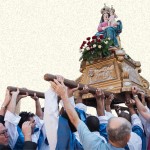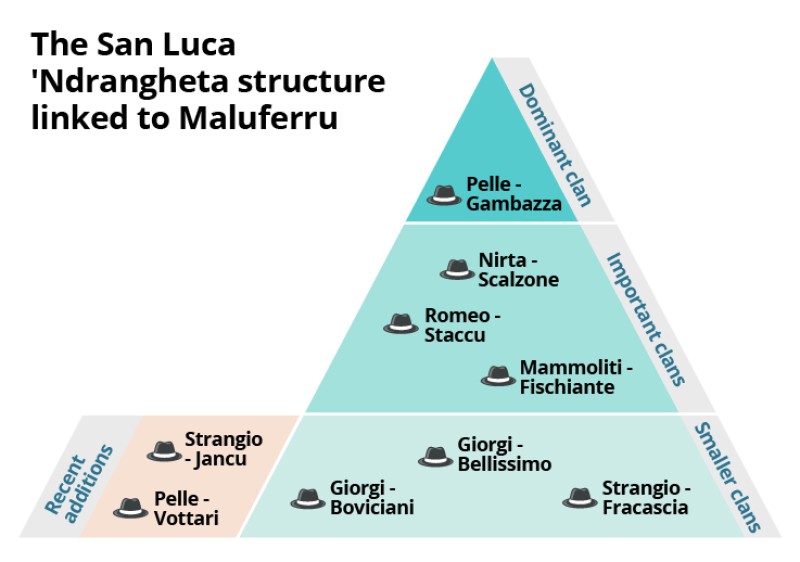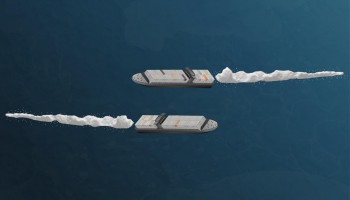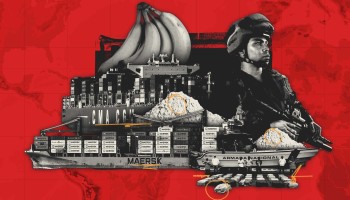In his younger years, the Italian drug trafficker Giuseppe Romeo, known as “Maluferru,” was fascinated with Mexican narcos.
In particular, police sources familiar with the trafficker say, he admired Los Zetas, the hyper-violent cartel known for beheadings, bombings, and brazen attacks on Mexican government troops.
But in real life, Maluferru and his brothers — all of whom worked with southern Italy’s ’Ndrangheta syndicate, the clan-based crime group which has grown to become the country’s most powerful in recent decades — showed no fear of Mexican narcos.
In one incident breathlessly recalled by underworld figures in 2016, his gang had a shootout with a Mexican gang on the streets of an unnamed European city, scaring them off.
“They started shooting three, four times in the middle of the road,” one ’Ndrangheta associate was heard telling another in a bugged chat. Another time, according to the same criminals, Maluferru let Mexican traffickers hold one of his own brothers hostage for eight days, as collateral for a 2-million-euro drug shipment.
This cold, calculating approach to business may run in the family.
Maluferru’s father, Antonio Romeo, ran the well-connected Romeo-Staccu clan of the ’Ndrangheta until he was arrested in the mid-1990s and sentenced to 30 years in prison.
After taking the reins of his family’s trafficking operations, Maluferru became a rare connector of worlds: a man with the necessary contacts in Latin America to secure huge supplies of cocaine, and in Europe to get the drugs through key ports.
As part of a group known in underworld circles as the “Gang of Belgium,” he sourced cocaine in Colombia and Brazil, had it shipped through the Ivory Coast, and brought it in through the docks of Northwest Europe: Antwerp, Hamburg, and Rotterdam. At every stop, he charmed and bullied other narcos into doing his bidding, and deployed tricks of the trade to conceal shipments that made him one of Calabria’s biggest-ever traffickers.
He had a reputation for keeping out of trouble. One client of his was heard on wiretaps saying admiringly that Maluferru had only once been “f**cked,” when 18 bricks of cocaine were seized from a stash house.
Maluferru roughly translated means “armed and dangerous.” But today Giuseppe Romeo is at least no longer armed. On March 11, he was arrested in Barcelona in an Interpol-led investigation with Spain’s Guardia Civil and Italian police.
Two months later, many of his ’Ndrangheta associates, including his former clients from the Giorgi-Boviciani clan, covered in Part 1 of this series, were arrested in Operation Platinum, a separate cross-border raid which targeted the crime group around Europe. Already provisionally sentenced by Italian authorities to 20 years in absentia for international drug trafficking, Maluferru has now been extradited and faces fresh charges.
Once described by a fellow narco as being able to ship cocaine “mancu li cani” — meaning “like nobody else” in the Calabrian dialect — Maluferru had, since 2008, built a globe-spanning empire that moved tons of drugs into Europe’s ports.
What follows, based on court and police documents, Italian orders of custody, and interviews with law enforcement sources, is an inside look at his alleged narcotics system: how it was built, how the drugs ran through it, and why it eventually collapsed.
Giuseppe Romeo and other characters in the following cases are still awaiting trial on some of the charges they face, and not all allegations outlined have been proven in court. A lawyer who represents Romeo told OCCRP and IrpiMedia that he did not wish to respond to questions due to ongoing criminal proceedings. His client, the lawyer said, is innocent of the crimes of which he has been accused.
A Hometown
The village of San Luca lies at the toe of Italy’s boot, separated from Reggio Calabria, the region’s main city, by the Aspromonte mountains. Despite its vantage point wrapped into the hills overlooking a valley, the town of 4,000 lacks most of the charms you’d expect from Italian villages. Walking through its narrow streets, the drab houses are lined with drying laundry, and unfinished homes give the distinct feel of hardship.
But looks can be deceiving. San Luca is the spiritual home of the ‘Ndrangheta, maybe the world’s most powerful organized crime gang. A majority of the town's population is affiliated with one of at least nine important crime clans that started in the village.
A short drive from San Luca into the mountains of a nearby national park lies the Sanctuary of Santa Maria di Polsi, perched on a dramatic gorge. The abbey is closely associated with the annual meeting of the Crimine, the ‘Ndrangheta’s governing body.
It was here in San Luca that Maluferru, then aged 16, had his first run-in with police over a fraud and stolen goods case. By 22 he’d already been charged with drug trafficking and had moved beyond San Luca like many sons of the ‘Ndrangheta, which exports its operations by exporting its people. But despite his rapid rise through the family ranks, it was only in the mid-2010s that his alleged role in several high-profile operations would bring him to global prominence.
Maluferru did not start at the bottom. His clan, the Romeo-Staccu, is believed to be aligned with the leading Pelle-Gambazza clan, which shares control of Calabria’s Locride area, and is known for its prowess in drug trafficking.
These powerful clans are also aligned with the other respected San Lucan clans like the Nirta-Scalzone and the Mammoliti-Fischiante, as well as the smaller ones like the Giorgi-Boviciani, the Giorgi-Bellissimo and the Strangio-Fracascia.
Maluferru nimbly used all of these San Luca connections to build his powerful drug trafficking network. But unlike many of his peers, he was never convicted of the common charge of “mafia affiliation” with the ‘Ndrangheta, which Italian prosecutors often levy against criminal actors.
In fact, his prowess in the trade was not immediately clear to the police. Using snippets of information gleaned from their surveillance of other Europe-based narcos, cops slowly came to understand that Maluferru — whose diminutive appearance led his enemies to call him “The Dwarf” — had an outsized influence on underworld affairs.
By 2015, he was a key part of the Gang of Belgium along with his brothers Domenico and Filippo, as well as Antonio Calogero Costadura, a Belgium-born narco also of Calabrian origin known as “U Tignusu,” meaning “The Bold.”
At that stage, Maluferru had already made a fortune and built a Rolodex of underworld connections that any rising narco would envy. The Gang of Belgium’s name undersold its influence, since it operated well beyond Belgium.
Receiving drug shipments from Latin America, the gang used criminal connections at European ports to help extricate these drugs, before moving them into Italy and other parts of the continent. Maluferru had a regional network operating between the Netherlands, Italy, Spain, and Germany. Apart from a few trusted contacts, sources say, he kept his distance from many ’Ndrangheta figures, helping him to remain at large within Europe even as others were attracting the attention of police and getting arrested.
How the Ports are Pried Open
Colombia, Bolivia, and Peru produce the vast majority of the world’s cocaine, with most Europe-bound cocaine leaving Latin America via Brazil, according to the United Nations. The port of Santos has become one of the most important trafficking arteries to Europe, according to Europol.
Police finally made major inroads into his empire with the launch of Operation Pollino, a December 2018 raid by Eurojust, the EU’s cross-border judicial body. Around four tons of cocaine were seized and 84 ’Ndrangheta members and brokers, including Maluferru’s two brothers, were detained. Based on calls intercepted during Operation Pollino, Italian police suspected Maluferru was moving drugs from European ports to Milan.
Although the Pollino dragnet ensnared most of the Gang of Belgium, Maluferru evaded capture. He was traced to an address in Kierspe, a town an hour outside Cologne, but when German authorities searched the Kierspe house, he was gone.
Crucially, however, investigators were able to establish a pattern of his activities after inserting spyware on the phone of Domenico Pelle, a young clan boss from San Luca who had been buying cocaine from the Gang of Belgium.
Meanwhile, two separate operations — one led by Turin’s antimafia prosecutor’s office, and another by their counterparts in Genoa and Naples — were putting Maluferru under further scrutiny.
The first, a years-long probe code-named “Geenna,” resulted in arrest warrants issued in December 2018 against San Luca’s Nirta-Scalzone clan and their associates. One element of this investigation targeted two brothers who had worked with Maluferru in Barcelona since 2016.
The investigation was important because it outed the Costa Brava region near Barcelona as an important drug trafficking center, and effectively wiped out the leaders of the Nirta-Scalzone clan.
A second equally momentus police sting, begun in 2018 and codenamed “Spaghetti Connection,” first traced a global trafficking system involving Maluferru, which police believed began in São Paulo and reached Abidjan in the Ivory Coast, before winding its way to Rotterdam and Antwerp.
Together, these two operations painted a picture of his expanded dealings, not only in Europe but now halfway across the world.
Lessons From the Costa Brava
Maluferru built a particularly trusted network in Spain, where he flitted between various safe havens. His contacts there included two brothers from the Nirta-Scalzone clan, Giuseppe and Bruno Nirta. Elsewhere, he had also teamed up with a third Nirta brother, Antonio.
Maluferru lived for a time in Calella, a coastal town less than an hour’s drive from Barcelona. Documents seen by reporters show his address was a nondescript property where he lived with his Colombian girlfriend and Vincenzo Macrì, an ’Ndrangheta fugitive at the time.
The Women in Maluferru’s Life
He may have been moving within the macho world of narco-trafficking, but police and other sources say Maluferru relied on a few key women to get to where he was.
Much of what authorities would later learn about the group’s dealings in Spain and elsewhere stemmed from the cooperation of Daniel Panarinfo, who was once a grunt for Bruno Nirta but turned state’s witness in 2016.
Among many schemes while Maluferru was partnering with Giuseppe and Bruno Nirta, the brothers had hatched plans to traffic liquid cocaine from Latin America to southern Spain, Panarinfo said. With a man nicknamed “Xavi” — a Catalonian fruit juice entrepreneur who, according to Panarinfo, had direct contact with Colombian narcos — they planned to open a company, ostensibly to import juice from Argentina.
Liquid cocaine would be hidden into juice boxes and sent to Spain at a cost of 12,000 to 13,000 euros per kilo, then unloaded at a Spanish port by a group of allied Albanians. The shipments would then be sent to a warehouse in seaside Sitges, a 45-minute drive from Barcelona, where a man called “Compañero” was trusted to re-solidify the drugs.
Investigators were unable to confirm whether the scheme ever got off the ground, but our reporters found that Xavi is still running beverage companies in Calella.
Around the same time, Maluferru was moving between Spain, Italy, and Belgium, buying loads of cocaine from a family of Calabrians based in the northern Belgian city of Maasmechelen. They were supplied by Colombian cartels, with their shipments from Latin America collected at Antwerp and Rotterdam and then sold by Maluferru to buyers like the Giorgi-Boviciani clan from San Luca.
Panarinfo also said Maluferru took delivery of at least 170 kilos of cocaine from Mexican suppliers, a part of which were then stored in Italy by his main helper, a Calabrian known as “Pitti.” Although Maluferru’s gang managed to sell 100 kilos, 70 were stolen from his apartment in Saronno, northwest of Milan, by men sporting balaclavas who broke down the door with a ram at five in the morning.
Such setbacks, however, did little to slow Maluferru’s rise. As the months went by, he began to move with bigger and bigger players.
Branching Into the Big Time
According to Panarinfo, Maluferru also worked with Gabriele Biondo, alias “El Italiano,” one of the most powerful narcos on the Costa Brava. Biondo, who police sources told OCCRP was known to work with Italy’s Camorra crime group and even the Russian mafia, would eventually be arrested and extradited to the U.S. in early 2019 to face trafficking charges.
Through relatives on his mother’s side of the family, Maluferru could also rely on key contacts in the Strangio-Fracascia, another clan from San Luca who were based in Belgium and could offer him access to the port of Antwerp, police said.
His allies in the Pelle-Gambazza clan, meanwhile, had allegedly established a major trafficking hub in Argentina, and are believed to have opened the door for Maluferru to Rocco Morabito, another top ’Ndrangheta broker before his arrest in May 2021 in Brazil. Morabito is from the ‘Ndrangheta stronghold of Africo, which is just south of San Luca and is on paper one of Italy’s poorest towns, but is home to wealthy drug-trafficking families.
Once known in the media as the “cocaine king of Milan,” Morabito had been on the run since the mid-1990s and famously escaped a Uruguayan prison in 2019. Among other sources, police believe that he was receiving cocaine from Colombia’s Clan del Golfo, a right-wing paramilitary group.
As if that wasn’t enough, Maluferru had also begun to source drugs via Nicola Assisi, who ran a huge smuggling operation from Brazil with his son while both were on the run from Italian authorities. Assisi, from northern Calabria, had been one of the top ’Ndrangheta narcos in Latin America for years. Sending shipments to Europe of at least 500 kilos at a time, he maintained his position due to a strong relationship with Brazil’s First Capital Command (PCC), a prison-based crime syndicate.
The PCC has been known to work with the former rebels of the Revolutionary Armed Forces of Colombia, known as FARC, to source drugs grown in the Colombian jungle. The group also enjoys major influence in cocaine-producing Peru and Bolivia and transit countries like Paraguay.
Between Morabito, the Assisis, and the PCC, Maluferru’s Latin American pipeline was the narco-trafficking gold standard. Even random timing seemed to work in his favor: When the Assisis were arrested in the state of São Paulo in July 2019, Morabito’s Uruguay prison break meant Maluferru’s supply went uninterrupted.
But besides dumb luck, Maluferru was also smart and cautious. One narco, clearly impressed by his tradecraft, explained to a colleague how Maluferru kept investigators at bay.
"It's like … he buys ten phones that last six months each, you understand? He gives you one, he gives him one, he gives one to the other and he keeps one for himself. Then he gives his phone to another guy and takes his, so he can confuse investigators," he said, according to police transcripts from Operation Pollino.
The irony, of course, was that whatever precautions Maluferru took himself, police were still learning plenty about him secondhand from tapped calls with his associates.
The Abidjan Operation
Not content to rest on his Latin American contacts, Maluferru continued to expand, and soon had his sights on transit points in Africa. And through confidential documents, OCCRP and IrpiMedia learned how he was likely behind a high profile cocaine importation plot that saw four Italians handed lengthy sentences in 2021, while he went free.
According to investigators it was a Swiss-born dentist who first connected Maluferru to a set of Italian entrepreneurs from Naples living in Abidjan, all linked to Italy’s Camorra.
Maluferru, documents show, had first traveled to the Ivory Coast in 2018, with the dentist securing him direct access to a key Ivorian facilitator: a policewoman who provided him with immigration permits and access to a flat in Abidjan’s upmarket Zone 4, rented in her name.
Through an Italian restaurateur in the city, the dentist had also been introduced to Angelo Ardolino, owner of two Abidjan-registered companies: A.G.L. Sarl, which was set up to import and export heavy machinery, and Fruit Company di Ardolino, established for the import and export of fruits. Ardolino, who has an Ivorian romantic partner, also had family ties to a top customs officer at the African port.
Ardolino, via A.G.L. Sarl, provided the paperwork needed for obtaining Ivory Coast visas, allowing Maluferru to travel regularly to Abidjan. According to documents from the 2018 Spaghetti Connection investigation, he was sometimes accompanied by Antonio Nirta — the only Nirta brother left in the game after Giuseppe was shot dead in 2017 and Bruno was arrested in 2018. Maluferru was also supported in Abidjan by his sidekick Pitti, and a cousin.
With the help of the Neapolitan businessmen linked to the Camorra, Maluferru and his crew allegedly started importing cocaine to Abidjan directly from Brazil using A.G.L. Sarl, which received Dynapac and Caterpillar heavy machinery from the port of Santos.
On September 17, 2018, as part of Spaghetti Connection, Santos police seized 1,195 kilos of cocaine inside the rollers of Caterpillar machines. Using a Santos-based company called Brazilian Ocean Eireli, the gang had cut the rollers open in Brazil with a blowtorch, hid the drugs in the cylinder, and then welded the machinery back together for shipping to Abidjan.
Brazilian Ocean Eireli is owned by a man Brazilian police suspect is connected to the PCC prison gang. Italian investigators, for their part, believe the cocaine supply was organized with the help of Assisi, the ‘Ndrangheta’s man in Latin America with the PCC connections.
The Santos seizure didn’t stop the culprits, who thought it was a random bust. But Brazilian police alerted Ivorian police, who alerted their Italian counterparts. In a joint operation, police tracked the dentist when he travelled to Abidjan on October 26, 2018, which eventually led them to Maluferru’s circle.
Investigators suspect the gang had been shipping cocaine in Caterpillar machinery since at least July 2017, with Brazilian police tracing two Caterpillar shipments from Brazilian Ocean Eireli to A.G.L. Sarl in Abidjan. Ardolino’s fruit import-export operations also came under suspicion, but it proved a trickier operation to crack.
“We have always suspected some of the cocaine could have also passed via fruit shipments,” an Italian investigator told OCCRP, “but it was hard to prove … given that, when we started investigating, the gang had already been importing for a while.”
From December 2018 onwards, Maluferru’s movements were increasingly restricted because he was wanted over a warrant issued in Operation Pollino. From then on, one of his associates remained in Abidjan to do the work for him, opening a new import-export company on February 26, 2019, registered at a postal box in the city.
Cops Build a Profile
By his mid-30s, Maluferru had made lasting impressions on a lot of narcos — not all of them positive.
The informant Panarinfo described him to police as “short, a little bald,” and someone who, “seems to me to have a scar or pimples on his cheekbones, lean physique, ash blonde hair not so long.”
Alessandro Giagnorio, used by Maluferru as a money courier, also gave an unflattering description after he was busted in late 2018 in an Audi Q3 with French plates, in which police found 420,000 euros belonging to Maluferru and his partners.
Spilling the beans to police, Giagnorio called Maluferru “short, thin, on edge, bossy, and rude. When I say ‘fast’ I mean that in three minutes he would tell you what you had to do, real quick, talking with a strong Calabrian accent, and you had to really pay attention to understand what he was saying.”
Maluferru had a reputation as a loose cannon, and some called him "U Pacciu," or The Crazy One. He showed little respect, it was said, because he was used to being surrounded by weaker characters who treated him with deference.
Once, Maluferru sent Giagnorio to a restaurant owned by Walter Cesare Marvelli, a member of the Giorgi-Boviciani family, to pick up some cash for travelling expenses. Marvelli, separate wiretapped conversations showed, was shocked by how rude Maluferru was, treating him like an employee. He recalled:
"Sunday afternoon … he [Maluferru] says, ‘I am sending a person to your pizzeria in an hour’s time. You give him 1,000 euros … he is coming down from France.’”
“I told him [Maluferru], ‘You are joking … I am in the centre of Turin with my family.’ [And he says], ‘You are always around.”
But even if they sniped behind each other’s backs, in person Maluferru and Marvelli kept up appearances.
In August 2018, the pair traveled together to a lunch meeting planned with other San Luca narcos in a rural area near the Sanctuary of Santa Maria di Polsi. The prospect of tucking into traditional mountain fare left them unimpressed.
"I don't give a f*** about goat," Marvelli, who was being tracked by police, exclaimed in a bugged conversation in the car.
During the drive, the pair lambasted the famed Italian anti-mafia prosecutor Nicola Gratteri. Marvelli dismissed the authorities’ crusade as a charade, reasoning that the prosecutors wanted the ’Ndrangheta around so that they could become famous.
"If you don't have sick people, you don't sell medicine," he said.
Police investigations, however, suggest that Maluferru’s ambition was already beginning to erode relations. Operation Platinum documents seen by our reporters show that by November 2018, the Giorgi-Boviciani in particular had grown tired of him.
Because the Giorgis were buying cocaine near the end of the pipeline, they paid a higher price. Some had started to suspect the better-connected Maluferru was ripping them off.
On one bugged call, Giovanni Giorgi told Marvelli that Maluferru was pretending to secure cocaine for the Giorgis at “27,” but instead “bought it at 24 and stole three points.”
As a result, the Giorgis started trying to bypass Maluferru. But they soon found he had the supply locked down, having even muscled in on their own hard-won channel with the Assisis in Brazil. Boxed out, the Giorgis could do little but complain — and the more they complained, the more information the police gathered.
Maluferru’s Downfall
By the end of Maluferru’s run, he had allegedly worked with a who’s-who of international traffickers, even apparently the cartel he admired the most, Los Zetas.
Under questioning, the cooperator Panarinfo told police that Maluferru had inherited some Mexican contacts from a jailed uncle. He said these men were called “Zeta” or “Zita,” indicating they were from the same cartel whose barbaric videos Maluferru had once studied.
But a combination of his own hubris, his partners’ vulnerabilities, and dogged police work would eventually get the better of him. Court records show Maluferru had a reputation for double-crossing people, and always seemed eager to bind himself to others, so that they would later owe him favors. Such tactics can prove fruitful in the short term, but eventually people get to talking.
In one intercepted call in 2016, a trafficker told Domenico Pelle that Maluferru’s brother, Filippo, had offered him drugs at 31,000 euros per kilo, to be paid whenever he was able. The trafficker, however, felt the cocaine was really coming from Maluferru, and he didn’t want to be in the latter’s service.
“If Maluferru gives me [even] a gram as a present, I don't want it,” he said.
After the Operation Pollino raids of December 2018 took out most of his Gang of Belgium, Maluferru was still a fugitive, but evidence was slowly mounting against him.
In June 2019, a raid coordinated by police in France, Italy, and Brazil swept up A.G.L. Sarl’s owner Ardolino and five other Italians linked to the Camorra. The arrests offered a rare glimpse into how the Camorra and ’Ndrangheta shared overlapping interests, thousands of miles from their Italian homeland.
And they also offered cops some final parts of the jigsaw.
Ardolino admitted knowing Maluferru and told cops that the latter had wanted to invest 1 or 2 million euros in the Ivory Coast. Antonio Cuomo, another of those arrested, denied knowing Maluferru and other Calabrians in his crew, but during a search police found IDs belonging to the Calabrians in his house.
The Ivorian cop — though later cleared of all charges — had admitted having helped with visas for a number of Calabrians, and to finding the Abidjan flat for Maluferru. In February 2021, four of those arrested, including Ardolino, were sentenced to 20 years in prison.
After a few more frantic weeks behind the scenes, in March 2021 Spanish Guardia Civil, having received a tip-off from Italian police working on the Pollino probe, swooped in on Maluferru as he went for a beer at Barcelona’s Sant Gervasi market.
Although he made many enemies along the way, one thing they could agree on was that Maluferru was good at what he did. Even the Giorgi-Boviciani, using their unflattering nickname for him, were willing to admit as much.
“You know the Dwarf,” Giovanni Giorgi was heard saying in one bugged conversation at his Sardinia apartment. “If you want it, he has it. It's a matter of days.” Maluferru, an associate reminded Giovanni, shipped cocaine “mancu li cani.”
Maluferru was indeed moving cocaine “like nobody else.” In the end, though, his biggest problem was that everybody else was being listened to by the cops.
“Everyone was after him,” a Guardia Civil officer involved in the arrest explained to OCCRP. “The Italians warned us he could be in Barcelona. Here, we put him in the lasso.”
Nathan Jaccard, Luis Adorno, Benedikt Strunz, Leanne de Bassompiere, and Jelter Meers contributed reporting.
This story was partly funded by grants from Journalismfund.eu and Reporters in the Field.
















